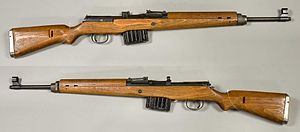Gewehr 43
| Gewehr 43 | |
|---|---|

Gewehr 43 from the collections of the Swedish Army Museum
|
|
| Type | Semi-automatic rifle |
| Place of origin | Germany |
| Service history | |
| In service | 1943–1945 |
| Used by |
Germany German Democratic Republic |
| Wars | World War II |
| Production history | |
| Designer | Walther |
| Designed | 1943 |
| Produced | 1943–1945 |
| No. built | 402,713 |
| Specifications | |
| Weight | 4.4 kg (9.7 lbs) |
| Length | 1130 mm (44.5 in ) |
| Barrel length | 550 mm (21.5 inches) |
|
|
|
| Cartridge | 7.92×57mm Mauser |
| Action | Gas-operated short-stroke piston, flapper-locked |
| Muzzle velocity | 746–776 m/s (2,448–2,546 ft/s) |
| Effective firing range | 500 m, 800 m with scope |
| Feed system | 10-round detachable box magazine, stripper clip fed |
| Sights | Iron sights, Zf42 optical crosshair sight |
The Gewehr 43 or Karabiner 43 (abbreviated G43, K43, Gew 43, Kar 43) is a 7.92×57mm Mauser caliber semi-automatic rifle developed by Germany during World War II. The design was based on that of the earlier G41(W), but incorporating an improved short-stroke piston gas system similar to that of the Soviet Tokarev SVT-40, and it incorporated innovative mass-production techniques.
Germany's quest for a semi-automatic infantry rifle resulted in two designs – the G41(M) and G41(W), from Mauser and Walther arms respectively. The Mauser design was introduced in 1941 and at least 12,755 were made, but it proved unreliable in combat. The Walther design fared better in combat but still suffered from reliability problems. The problems with both designs stemmed from a demand made by the Army that the rifles not use holes drilled into the barrel, known as ports, to run the automatic loading mechanism. Meeting this requirement meant the designs had to use uncommon mechanisms that were simply unreliable and highly prone to fouling.
The German invasion of the Soviet Union led to small numbers of the SVT-40 being captured and returned to Germany for examination. These used a simple gas mechanism powered from a port cut into the barrel about 1/3 of the way back from the end, and replaced the conventional stripper reloads with a modern box magazine. It was clearly superior to the G41's, and simpler as well. In 1943, Walther combined a similar gas system with aspects of the G41(W) providing greatly improved performance. It was accepted and entered into service as the Gewehr 43, renamed Karabiner 43 in April 1944, with production amounting to just over 400,000 between 1943 and 1945.
In 1941, Nazi Germany invaded the Soviet Union as part of Operation Barbarossa. Just prior to the opening of hostilities the Soviet Red Army had started re-arming its infantry, complementing its older bolt-action rifles with the new semi-automatic SVT-38s and SVT-40s. This proved to be somewhat of a shock to the Germans, who ramped up their semi-automatic rifle development efforts significantly.
...
Wikipedia
